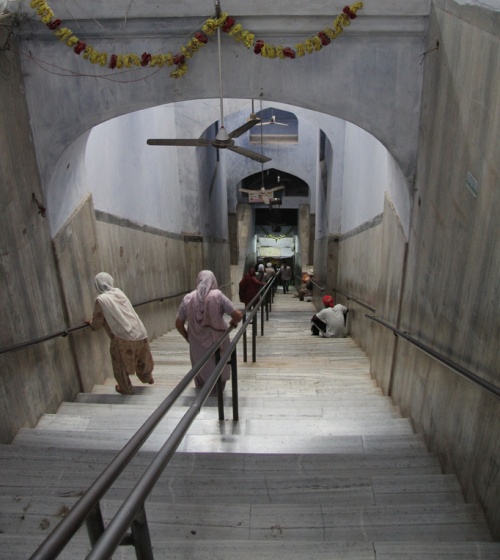BAOLI or bavali is a masonry well with steps leading down to water level. This is perhaps the oldest type of well introduced when man had discovered the existence of subsoil water and also the means to reach it, but had not yet invented mechanical devices to draw water out of it. Before masonry art was developed, baolis must have been only shallow pits with a sloping path down to the water, vertical walls and dented steps confined only to rocky regions.
Gradually as the arts of brick making and masonry developed, baolis began to be constructed in the plains and, although subsequently use of pulleys and, still later, of the Persian wheel was introduced to bring water up to the surface of the earth, the vogue of baolis continued up to comparatively more recent times.During early Sikhism, successive Gurus raised several villages and towns across the Punjab, with ponds and baolis, especially in areas where water was scarce.
In the Sikh system the importance of daily morning bath (snana) is stressed equally with nam (meditation on God`s name) and dan (charity). A historically famous baoli` which is today an important pilgrim site for the Sikhs was built by Guru Amar Das (1479-1574) at Goindval, town he had himself founded.
More Information
Founding of the Village Goindwal
A trader by name of Goinda hoped to establish a post at the ferry landing to take advantage of the traffic of the crossroads. He encountered a great many difficulties launching his venture. Fearing demonic interference, he asked Second Guru Angad Dev’s blessing on his project. Amar Das, a devoted disciple of Guru Angad, carried water every day from the ferry landing to the nearby village of Khadur where Guru Angad and his followers resided. Guru Angad asked his faithful follower Amar Das to oversee the project. The second guru gave Amar Das a staff with instructions that it should be used for the removal of any obstacles. Amar Das successfully helped to lay the foundation of a village became which came to be known as Goindwal after the trader Goinda.
The Gurus and Goindwal
Goinda had a special place built in Goindwal to honor Guru Angad Dev. The Guru requested Amar Das to make Goindwal his home. Amar Das slept in Goindwal nights. During the day he resumed his duties and carried water to Khadur for Guru Angad’s morning bath. Along the way, Amar Das recited the hymn “Japji Sahib”, the Sikh’s morning prayer. He stayed in Khadur to hear the hymn of “Asa Di Var,” a composition of Guru Angad interspersed with hymns by First Guru Nanak, the founder of Sikhism. He then returned to Goindwal to fetch more water for the guru’s free communal kitchen and carried it back to Khadur. Guru Angad Dev selected Amar Das as the most faithful of his Sikhs and appointed him to be his successor. When Amar Das became the third guru, he moved permanently to Goindwal with his family and followers.
Goindwal Baoli, the Well of Goindwal
Guru Amar Das arranged for a baoli, or covered well, to be constructed in Goindwal in order to serve the needs of Sikhs and other visitors. The ancient well he built has become a popular historic Sikh shrine. In modern times, the well spans about 25 feet or 8 meters. Arched access opens to a domed entrance decorated with frescoes depicting the life of Guru Amar Das. A divided underground staircase with 84 covered steps descends beneath the earth to the well’s sacred waters. One side of the staircase is for the use of women and the side other for men.
Each step is thought to represent 100,000 life forms of a possible 8.4 million existences. Many devotees visiting Goindwal Baoli Sahib recite the entire hymn of “Japji” on each step. The devotees first descend to bathe and perform ablution in the waters of the well. Next devotees begin to recite Japji on the lowest step. After completing the prayer, devotees return to water of the well for another dip. Devotees then move on to the next higher next step, repeating the prayer and performing in all 84 complete recitations, in hopes of being liberated from transmigration.



